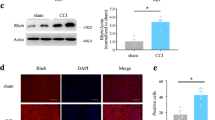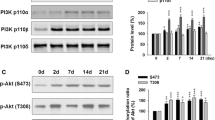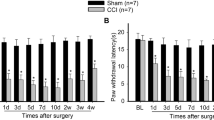Abstract
The cerebrospinal fluid-contacting nucleus (CSF-CN) has been demonstrated to be involved in neuropathic pain, but the underlying molecular mechanisms remain unclear. Previous work has shown that mTOR and ERK1/2 are important signaling pathways regulating neuropathic pain. However, studies on the interactions between these major pathways in neuropathic pain are very rare. Therefore, the purpose of this study is to determine whether mTOR and ERK1/2 exist in the CSF-CN and elucidate their alterations in neuropathic pain, especially, the crosstalk between them. Our results showed that mTOR and ERK1/2 were distributed in the CSF-CN, and their expression levels were increased in chronic constriction injury (CCI)-induced neuropathic pain. Furthermore, the injection of both the mTOR antagonist rapamycin and the ERK1/2 antagonist U0126 into the lateral ventricle of the brain attenuated CCI-induced neuropathic pain. Inhibition of the ERK1/2 pathway had little impact on mTOR signaling, but inhibition of the mTOR pathway significantly increased ERK/2 signaling. The coadministration of rapamycin and U0126 inhibited the rapamycin-induced upregulation of ERK, and had a greater effect on pain behaviors than did the single-drug administrations. These data extend our understanding of the relationship between mTOR and ERK in the supraspinal site and demonstrate that the CSF-CN participates in neuropathic pain via the regulation of mTOR and ERK1/2.











Similar content being viewed by others
References
Costigan M, Scholz J, Woolf CJ (2009) Neuropathic pain: a maladaptive response of the nervous system to damage. Annu Rev Neurosci 32:1–32
Navarro X, Vivo M, Valero-Cabre A (2007) Neural plasticity after peripheral nerve injury and regeneration. Prog Neurobiol 82(4):163–201
Vignot S, Faivre S, Aguirre D et al (2005) mTOR-targeted therapy of cancer with rapamycin derivatives. Ann Oncol 16(4):525–537
Yang Z, Klionsky DJ (2010) Mammalian autophagy: core molecular machinery and signaling regulation. Curr Opin Cell Biol 22(2):124–131
Gingras AC, Raught B, Sonenberg N (1999) eIF4 initiation factors: effectors of mRNA recruitment to ribosomes and regulators of translation. Annu Rev Biochem 68:913–963
Costa-Mattioli M, Sossin WS, Klann E, Sonenberg N (2009) Translational control of long-lasting synaptic plasticity and memory. Neuron 61:10–26
Jimenez-Diaz L, Geranton SM, Passmore GM et al (2008) Local translation in primary afferent fibers regulates nociception. PLoS ONE 3(4):e1961
Geranton SM, Jimenez-Diaz L, Torsney C et al (2009) A rapamycin-sensitive signaling pathway is essential for the full expression of persistent pain states. J Neurosci 29(47):15017–15027
Zhang W, Sun XF, Bo JH et al (2009) Activation of mTOR in the spinal cord is required for pain hypersensitivity induced by chronic constriction injury in mice. Pharmacol Biochem Behav 111:64–70
Obara I, Tochiki KK, Geranton SM et al (2011) Systemic inhibition of the mammalian target of rapamycin (mTOR) pathway reduces neuropathic pain in mice. Pain 152(11):2582–2595
Ji RR, Gereau RW 4th, Malcangio M et al (2009) MAP kinase and pain. Brain Res Rev 60(1):135–148
Ji RR, Baba H, Brenner GJ et al (1999) Nociceptive-specific activation of ERK in spinal neurons contributes to pain hypersensitivity. Nat Neurosci 2(12):1114–1119
Carracedo A, Ma L, Teruya-Feldstein J et al (2008) Inhibition of mTORC1 leads to MAPK pathway activation through a PI3 K-dependent feedback loop in human cancer. J Clin Invest 118(9):3065–3074
Vigh B, Manzano e Silva MJ, Frank CL et al (2004) The system of cerebrospinal fluid-contacting neurons. Its supposed role in the nonsynaptic signal transmission of the brain. Histol Histopath 16:607–628
Zhang LC, Zeng YM, Ting J et al (2003) The distributions and signaling directions of the cerebrospinal fluid contacting neurons in the parenchyma of a rat brain. Brain Res 989:1–8
Lu X, Geng X, Zhang L et al (2009) Substance P expression in the distal cerebrospinal fluid-contacting neurons and spinal trigeminal nucleus in formalin-induced the orofacial inflammatory pain in rats. Brain Res Bull 78:139–144
Wang J, Zhang S, Li L et al (2014) Involvement of Wnt5a within the cerebrospinal fluid-contacting nucleus in nerve injury-induced neuropathic pain. Int J Neurosci 125(2):147–153
Liu H, Yan WW, Lu XX et al (2014) Role of the cerebrospinal fluid-contacting nucleus in the descending inhibition of spinal pain transmission. Exp Neurol 261C:475–485
Wang CG, Ding YL, Zheng TF et al (2013) Extracellular signal-regulated kinase 5 in the cerebrospinal fluid: contacting nucleus contributes to morphine physical dependence in rats. J Mol Neurosci 50(1):215–220
Wahlbeck K, Sundblom M, Kalso E et al (1996) Elevated plasma vasopressin and normal cerebrospinal fluid angiotensin-converting enzyme in chronic pain disorder. Biol Psychiatry 40(10):994–999
McLean SA, Williams DA, Stein PK et al (2006) Cerebrospinal fluid corticotropin-releasing factor concentration is associated with pain but not fatigue symptoms in patients with fibromyalgia. Neuropsychopharmacology 31(12):2776–2782
Bennett GJ, Xie YK (1988) A peripheral mononeuropathy in rat that produces disorders of pain sensation like those seen in man. Pain 33:87–107
Popiolek-Barczyk K, Makuch W, Rojewska E et al (2014) Inhibition of intracellular signaling pathways NF-kappaB and MEK1/2 attenuates neuropathic pain development and enhances morphine analgesia. Pharmacol Rep 66(5):845–851
Wang XY, Yan WW, Zhang XL et al (2014) ASIC3 in the cerebrospinal fluid-contacting nucleus of brain parenchyma contributes to inflammatory pain in rats. Neurol Res 36(3):270–275
Asante CO, Wallace VC, Dickenson AH (2010) Mammalian target of rapamycin signaling in the spinal cord is required for neuronal plasticity and behavioral hypersensitivity associated with neuropathy in the rat. J Pain 11(12):1356–1367
Asante CO, Wallace VC, Dickenson AH (2009) Formalin-induced behavioural hypersensitivity and neuronal hyperexcitability are mediated by rapid protein synthesis at the spinal level. Mol Pain 5:27
Xu Q, Fitzsimmons B, Steinauer J et al (2011) Spinal phosphinositide 3-kinase-Akt-mammalian target of rapamycin signaling cascades in inflammation-induced hyperalgesia. J Neurosci 31(6):2113–2124
Shih MH, Kao SC, Wang W et al (2012) Spinal cord NMDA receptor-mediated activation of mammalian target of rapamycin is required for the development and maintenance of bone cancer-induced pain hypersensitivities in rats. J Pain 13(4):338–349
Zhang Y, Cai G, Ni X, Sun J (2007) The role of ERK activation in the neuronal excitability in the chronically compressed dorsal root ganglia. Neurosci Lett 419:153–157
Dai J, Bercury KK, Macklin WB (2014) Interaction of mTOR and Erk1/2 signaling to regulate oligodendrocyte differentiation. Glia. doi:10.1002/glia.22729
Wu TT, Zhao ZJ, Xu C et al (2011) Distribution of TRPC6 in the cerebrospinal fluid-contacting nucleus of rat brain parenchyma and its expression in morphine dependence and withdrawal. Neurochem Res 36(12):2316–2321
Acknowledgments
This study was funded by the National Natural Science. Foundation of China (81371243) and the Natural Science Foundation of Jiangsu Province (BK2012580).
Author information
Authors and Affiliations
Corresponding author
Rights and permissions
About this article
Cite this article
Li, G., Lu, X., Zhang, S. et al. mTOR and Erk1/2 Signaling in the Cerebrospinal Fluid-Contacting Nucleus is Involved in Neuropathic Pain. Neurochem Res 40, 1053–1062 (2015). https://doi.org/10.1007/s11064-015-1564-7
Received:
Revised:
Accepted:
Published:
Issue Date:
DOI: https://doi.org/10.1007/s11064-015-1564-7




